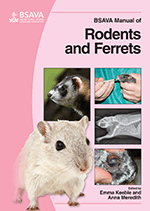
Full text loading...

The ferret is frequently used as a laboratory model and practitioners benefit from data derived from this source. In some cases, normal parameters are extrapolated from those established in other domestic carnivores. Collection of blood samples of adequate volume and quality is relatively easy, even in smaller ferrets. As in any other species, successful analysis depends on adequate sample volume and quality. It is worth practising and reviewing sample collection and handling techniques in order to minimize error due to artefact and poor sample quality. Safe volume collection in a healthy animal is up to approximately 10% of blood volume, which in the ferret is 6-7% of body weight. This chapter details Blood analysis; Clinical chemistry; Cytology and microbiology; and Other tests.
Ferrets: clinical pathology, Page 1 of 1
< Previous page | Next page > /docserver/preview/fulltext/10.22233/9781905319565/9781905319565.20-1.gif

Full text loading...





